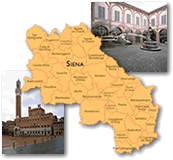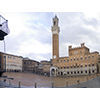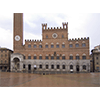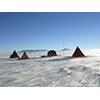Siena

The name of the city of Siena probably derives from that of a noble Etruscan family, Saina, widely attested in Chianciano, Chiusi and Perugia. Though a town definitely stood on this site as of the Roman age, it was only in the Upper Middle Ages, with the new Via Francigena, that the city acquired considerable importance. Becoming champion of communal freedom, Siena extended its territory to all of central-southern Tuscany. In addition to being an important economic centre, the city also had academies and university institutions, whose fame in scientific and medical research remained unaltered even after the loss of political autonomy halfway through the 16th century.
[Given the limitations on traffic in the historical centre, we advise you undertake the proposed itinerary on foot]
The very symbol of the city, the Torre del Mangia in the central Piazza del Campo, conceals inside a veritable masterpiece of seventeenth-century smelting technology: a bell weighing more than 6600 kilos.

To the left of the Palazzo Pubblico (Town Hall) stands the Torre del Mangia which, with its 88-metre height, symbolised communal freedom and the emancipation from feudal power. The first bell, by Florentines Riccardo di Tingo and his son Agostino, was set in place on the tower in 1347. The chronicles record the existence of a clock made in 1360 by Bartolomeo Guidi and restored before 1379 by Bernardino di Pietro from Rouen, and later by Don Gaspare degli Ubaldini. In 1425, the Jesuit Giovanni da Milano reconstructed it almost completely, modifying its entire clockwork. The hours were struck by an automaton initially made of wood (we know it existed already in 1396) and then of brass (1425).
In 1632, due to the bell’s defective sound, Antonio Ceranini from Novara made several unfortunate attempts to repair it. In 1665, it was decided to cast a new bell (the "Campanone"), entrusting Girolamo Santoni from Fano and Giovanni Battista Salvini from Siena with its realisation. The fusion process was carried out in the convent of San Francesco, lasting almost ten months, and was documented by Giovanni Maria Vieri. The bell was set in place (on September 23, 1666) with great difficulty, owing to its transportation and to the tower’s height. It took ten days and two large hoists operated by 53 men. Suffice it to consider that the bell weighed 6674 kilograms, was 1.98 metres high, and had a diameter of 2.34 metres.
(Antonella Gozzoli)
The adjoining Palazzo Pubblico, which conserves an interesting collection of locally made ceramics, was in the past the place which also housed the lost globe by Ambrogio Lorenzetti, a milestone in the history of Italian cartography.

Palazzo Pubblico, which was designed also to provide consolidation for the supporting wall between Piazza del Campo and Piazza del Mercato Vecchio below it, was built in various stages. It possess an extraordinarily valuable historic-artistic heritage, with works such as the Maestà of Simone Martini and the Good and Bad Government of Ambrogio Lorenzetti, as well as Italian and foreign paintings dating from the 16th to the 18th century, ceramics of Sienese manufacture dating from the 14th to the 18th century, and other precious collections.
In the Council Hall was placed the revolving Globe of Ambrogio Lorenzetti. Consisting of a round revolving frame covered in lightweight material, it was painted by the famous Sienese artist in 1345 but was lost a few centuries later. Unfortunately, no satisfactory descriptions of this instrument have survived. It is presumed, however, that it was a real topographic chart in which the Sienese State was symbolised as the centre of a constellation of satellites represented by the surrounding country and, in the background, by the other known lands.
(Antonella Gozzoli)
In the nearby Piazzetta Gigli, which is reached by following Via Giovanni Dupré, you can visit the Accademia dei Fisiocritici, the oldest and most prestigious scientific institution of Siena. Its illustrious past is recalled by an important museum of natural collections dating to the mid 18th century.
The Siena Academy of Sciences, known as the "Fisiocritici" (nature's judges), was founded in 1691 in the library of Siena's Hospital of Santa Maria della Scala by Pirro Maria Gabbrielli, professor of Medicine and Botany at the University of Siena. The primary objective of the Academy was that of studying the origins of natural phenomena through experimental verification, and its chosen emblem was the Touchstone, the Lapis Lidius in Latin, to indicate that the institution aimed to make known the truth, just as the Touchstone served to distinguish real from false gold. Moved in 1694 to a room in the Sapienza, seat of the University, after the disastrous earthquake of 1798 it was moved again to the former Camaldolensian Monastery. There the engineer Giuseppe Pianigiani faithfully reconstructed in engraved marble the "camera obscura" sundial that had been installed by Gabrielli in the former seat of the Academy in 1704, called by him the "Fisiocritic heliometer".
Considered one of the most famous cultural societies in Europe, the Academy had among its members such illustrious scientists as Antonio Vallisneri, Giovanni Battista Morgagni, Carl Linnaeus, Leonardo Ximenes, Lazzaro Spallanzani, Felice Fontana, Joseph-Louis Lagrange, Alessandro Volta, George Cuvier, Louis Pasteur and many others. From 1789 to 1815 it was guided by Paolo Mascagni, who conferred on it a more strongly scientific orientation.
The original core of the Academy's nature collections, now kept in the Museum, dates from the mid-eighteenth century. Particularly noteworthy are the "Paolo Mascagni" collection, which includes the books from his personal collection, the scientist's works, his family archive and the anatomical specimens prepared through the technique of injecting metallic mercury into lymphatic vessels; the "Francesco Valenti-Serini" collection, a vast number of terracotta models of edible and poisonous mushrooms, including models and panels showing the mushrooms at the various stages of their development and in section view; the "Francesco Spirito" collection, with anatomical specimens prepared through a petrification process developed in the first half of the 20th century by Francesco Spirito, professor of Obstetrics and Gynaecology.
The zoological collection is remarkable, with specimens of vertebrates and invertebrates, noteworthy among them the Mammals, marine ones in particular, collected from 1970 to the present along the coasts of Tuscany, and the geological collection, consisting mainly of samples from the territory of southern Tuscany, donated in the 18th and 19th centuries.
In the Historical Archives are handwritten documents pertinent to the life and history of the Academy and, more generally, to the history of Sienese science.
(Anna Toscano)
Close to the Accademia, next to the city walls in the vicinity of Porta Tufi, is the Botanical Garden of the University of Siena with special layouts dating to the 19th century, which houses a rare collection of tropical plants.
A medicinal herb garden proves to have been active in Siena at the Santa Maria della Scala Hospital as of the late 16th century. In 1788, twenty-five years after the transformation of the Chair of Medicinal Herbs into the Chair of Natural History, the Botanical Garden of the University was instituted at the Hospital, and in 1856 transferred to its current location at the Accademia dei Fisiocritici, continuing to be enlarged and transformed through the years.
The outdoor collection of plants includes numerous specimens systematically arranged, old specimens of exotic plants which testify to the nineteenth-century layout, and varyingly arranged indigenous plants. The greenhouse plants are housed in various structures: the hothouse built in the late 19th century by Attilio Tassi (director from 1860 to 1905), houses species from tropical zones; the tepidarium, used to house the exotic species in winter, has a section devoted to succulent plants cultivated on the ground and distinguished according to their country of origin; the lemon-house contains showcases with insectivorous plants, the collection of the main citrus trees cultivated in Europe, and the species utilised in experimental studies. Fruit-bearing trees, olive trees and grapevines, including the principle grapevines of Chianti, are also cultivated. This section of the Garden is currently being subjected to transformations to set up the new collections.
(Anna Toscano)
Finally, it will surprise many to discover that Siena is home to the Museo Nazionale dell'Antartide "Felice Ippolito", which you can reach backtracking towards Via di San Pietro and turning left towards Via Paolo Mascagni. The Sienese collection preserves a collection, unique in its kind, of more than 15,000 rock samples from the remote continent.

The desire to spread and make known the problems faced by the Italian researchers in Antarctica led, in 1996, to the institution of the National Museum of the Antarctica. The Museum is an Inter-university Centre of the Universities of Genoa, Siena and Trieste, each of which, according to its own specific field of competence, forms an independent section.
The Siena Section displays an Antarctic Rock Collection, consisting of around 19,000 rock samples collected during the course of 15 Italian expeditions to the Antarctica, continuously incremented by new samples. It also boasts over 1,100 samples of meteorites, around 500 of them found in the Antarctica. Visitors can "explore" the Antarctica through films, interactive posts and observation of rocks, minerals, animals and plants, both living and fossilised.
(Stefania Mangia)
****************************
Texts by Elena Fani
English translation by Victor Beard
Last update 09/ott/2008



 = libraries and archives
= libraries and archives  = scientific research centers
= scientific research centers  = memorial places of scientists
= memorial places of scientists = public health places
= public health places = places of science and worship
= places of science and worship = places of technology
= places of technology  = museums and collections
= museums and collections  = villas and gardens of science
= villas and gardens of science


